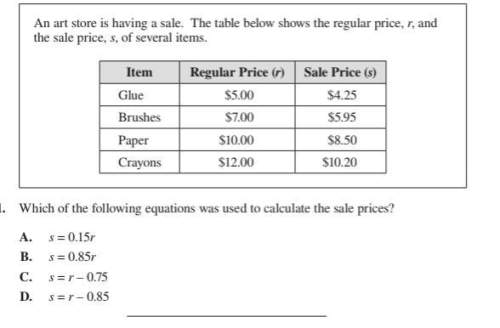What is the inverse of the function below?
f(x)=x-7/3
a.) f^-1(x)=-x+7/3
b.) f^-1...

Mathematics, 24.08.2019 17:30, soccer816
What is the inverse of the function below?
f(x)=x-7/3
a.) f^-1(x)=-x+7/3
b.) f^-1(x)=3/x-7
c.) f^-1(x)=x-7
d.) f^-1(x)=3x+7

Answers: 1
Other questions on the subject: Mathematics

Mathematics, 21.06.2019 14:00, fahaddakhil3186
Question 1(multiple choice worth 1 points)(07.06 mc)a group of students must collect at least $150 to organize a science fair. they have already collected $30. which graph best represents all remaining amounts of money, in dollars, that thestudents should still collect to organize the science fair? -210 -180 -150 - 120 -90-60 -300306090 120 150 180 210-210 -180 -150 - 120 -90 -60 -30 0 30 60 90 120 150 180 210-210 -180-150 - 120 -90-60-300 30 60 90 120 150 180 210-210 -180 -150 - 120.90 -60 -30 0 30 60 90 120 150 180 210
Answers: 3


Mathematics, 21.06.2019 17:00, vandarughb2875
The perimeter of a stage is 116 feet. it is 17 feet wide. how long is it?
Answers: 1

Mathematics, 21.06.2019 17:00, SillyEve
In tossing one coin 10 times, what are your chances for tossing a head? a tail? 2. in tossing one coin 100 times, what are your chances for tossing a head? a tail? 3. in tossing one coin 200 times, what are your chances for tossing a head? a tail? deviation = ((absolute value of the difference between expected heads and observed heads) + (absolute value of the difference between expected tails and observed tails)) divided by total number of tosses. this value should always be positive. 4. what is the deviation for 10 tosses? 5. what is the deviation for the 100 tosses? 6. what is the deviation for 200 tosses? 7. how does increasing the total number of coin tosses from 10 to 100 affect the deviation? 8. how does increasing the total number of tosses from 100 to 200 affect the deviation? 9. what two important probability principles were established in this exercise? 10. the percent of occurrence is the obtained results divided by the total tosses and multiplied by 100%. toss the coins 100 times and record your results. calculate the percent occurrence for each combination. percent head-head occurrence: percent tail-tail occurrence: percent head-tail occurrence:
Answers: 3
Do you know the correct answer?
Questions in other subjects:

English, 17.10.2021 14:00




History, 17.10.2021 14:00

Mathematics, 17.10.2021 14:00

Business, 17.10.2021 14:00










